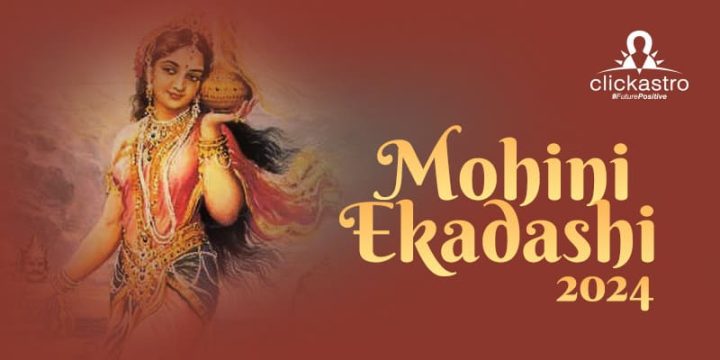Mohini Ekadashi
Ekadashis are pious occasions in Hindu culture. It is the eleventh tithi (day) of the fortnight. There are two Ekadashis in one month – the Shukla Paksha Ekadashi (waxing phase) and Krishna Paksha Ekadashi (waning phase). Ekadashis are generally dedicated to the worship of Lord Vishnu. Devotees observe vrat on this day to absolve sins and invoke the blessings of Lord Vishnu. The Shukla Paksha Ekadashi during the month of Vaishakha is called
Mohini Ekadashi. This usually falls in the April-May month according to the
Gregorian calendar. This Ekadashi sees the worship of Mohini, which is Lord Vishnu in female form.
When is Mohini Ekadashi 2024?
The 2024 Mohini Ekadashi falls on Sunday, May 19
Like with all Ekadashis, the
Mohini Ekadashi also is dedicated to Lord Vishnu – the one who sustains this universe. It is more widely observed in northern India. In the Tamil calendar,
Mohini Ekadashi falls in the month of ‘Chithirai’ and in the Malayalam Calendar, it falls in the month of ‘Edavam’. By observing Mohini Ekadashi, the faithful remember the role of Mohini, the charismatic incarnation of Lord Vishnu, in sustaining the balance of power in the Universe.
Check Hindu Calendar 2024
Important Timings On Mohini Ekadashi 2024
- Sunrise May 19, 2024 5:47 AM
- Sunset May 19, 2024 6:58 PM
- Dwadashi End Moment May 20, 2024 3:59 PM
- Ekadashi Tithi Begins – May 18, 2024 11:23 AM
- Ekadashi Tithi Ends – May 19, 2024 1:50 PM
- Hari Vasara End Moment – May 19, 2024 8:22 PM
- Parana Time – May 20, 5:47 AM – May 20, 8:25 AM
What are the rituals during Mohini Ekadashi?
The faithful observe strict fasting on this day. Actually, the fasting begins on the previous day (Dashami or the 10th day). It continues till sunrise on the next day (Dwadashi or the 12th day).
On the day of
Mohini Ekadashi, the faithful permit themselves to eat only ‘sattvic’ food. ‘Satt’ can be broadly described as the life force in food. Eating sattvic food means eating those foods which have a life force in them – fresh vegetables, fruits, nuts, etc are examples of sattvic food. Consuming sattvic food rejuvenates the body and mind. The sattvic diet is also a treatment procedure in Ayurveda. However, if the person has health problems and observing a strict diet is not possible, certain exceptions are made. Such persons can eat ‘falahar’ food i.e. food that is cooked. Such food can be made using vegetables, fruits, oil, and milk. Consumption of rice and all forms of grain is prohibited while observing
Mohini Ekadashi.
The devotee should sleep on the floor on Dashami night. On Ekadashi day, he or she must wake up early, before sunrise, and bathe in water with Til (sesame seeds) and Kush (darbha grass). They spend the day offering prayers and observing fast. Special mandaps (enclaves) are set up for Lord Vishnu where the deity is worshipped with agarbattis, sandalwood, flowers, and fruits. Offering Tulsi leaves is also considered auspicious. In some parts, Lord Rama is worshipped as he is considered an avatar of Lord Vishnu.
It is also customary for the
Mohini Ekadashi vrat or fasting to be broken by drinking milk on the next day. Avoid food given by outsiders during this time. Also avoid tamasic (harmful) food like meat, alcohol, and even onion and garlic while observing
Mohini Ekadashi vrat. The devotee should maintain a disciplined mind and should not get angry, violent, or get passionate about things at this time.
The story behind Mohini Ekadashi
Lord Vishnu took the form of enchantress Mohini to lure the asuras away from the pot of nectar obtained during the churning of the cosmic ocean. It is believed that Lord Vishnu took this form on the Ekadashi day of Vaishakha month. This set the precedent for celebrating
Mohini Ekadashi. It is believed that observing the
Mohini Ekadashi vrat bestows the devotee with Punya (bliss) that one attains from visiting pilgrimages and donating wealth, and also grants him/her moksha, or release from the never-ending cycle of birth and death. The story behind the virtue of
Mohini Ekadashi is believed to have been narrated to Lord Rama by Sage Vashishta and again by Lord Krishna to Yudhishtira. It is as follows:
In the village of Bhadravati located on the banks of River Saraswati, there lived a merchant called Dhanpaal. He was a pious man and a great devotee of Lord Vishnu. He helped the needy and was respected by those in his community. Dhanpaal had five sons. The fifth son was Dhrustbuddhi. Dhrustbuddhi was everything that Dhanpaal wasn’t. He was reckless, rude, and lived a life of vice and lust. He did not care for ethics in trade and openly lied and cheated the customers. He had a weakness for sex and encouraged infidelity and incest.
Being wealthy and powerful, the people had no choice but to put up with his nefarious acts. Finally, giving up on his youngest son ever developing a moral compass, Dhanpaal summoned Dhrustbuddhi and barred him from venturing out of the house. But Dhrustbuddhi showed no remorse. He truly was a rotten human being, to the core. While it pained him, Dhanpaal gave his youngest son two options – death or exile. Dhrustbuddhi chose exile.
He left the village and started the journey through the dense forest. Hunger, thirst, and exposure to nature’s elements obliterated whatever little civilized mannerisms existed in him. To survive Dhrustbuddhi killed animals and ate them raw and drank their blood. He became a savage. Leading a wandering life, Dhrustbuddhi one day arrived at the ashram of Kaudinya Rishi, situated on the banks of the holy river Ganga. The rishis were bathing in the river when Dhrustbuddhi arrived. He too jumped into the river. Upon coming into contact with the holy water of Ganga, something inside him changed. Guilt, sorrow, and self-pity suddenly overwhelmed him and Dhrustbuddhi began to wail like a little child.
Kaudinya Rishi approached him and enquired about him. Dhrustbuddhi told Rishi everything about his past life and how the weight of sins committed in the past was crushing him now. He begged Kaudinya to help him. Kaundinya Rishi saw the suffering in Dhrustbuddhi. He took him in and told Dhrustbuddhi that repenting for his actions was the first step toward Moksha. Then he further advised him to observe vrat during
Mohini Ekadashi.
Dhrustbuddhi did as he was told. As time went by he became less and less haunted by the sins of the past.
Dhrustbuddhi became clear in his mind and pious in his actions. He became revered and respected. He died as a holy man. When his time on Earth came to a close, Garuda came to take him to the heavenly abode of Vaikunth where Lord Vishnu resided. Dhrustbuddhi spends his afterlife serving the Lord. His story shows the power of the
Mohini Ekadashi Vrat. Observing Vrat during
Mohini Ekadashi will cleanse the devotee of his sins and help him or her attain Moksha. It is believed that Lord Rama, under the advice of Sage Vashishta, observed this Vrat when Maa Sita was abducted by the demon Ravana. Afterward, Lord Rama fought the epic war and killed Ravana to free Sita.
What is the Significance of Mohini Ekadashi in the modern world?
Mohini is one of the earliest examples of transgender personalities. Commemorating the role of Mohini in restoring the balance of power in the cosmos is a nod towards the celebration of sexual freedom and the virtue of the transgender community. The character of Mohini also lays bare the feminine side of the man in power. It stresses the power of feminine charm and seduction over war-mongering men blinded in their lust for power and control. Mohini also inspires people to rise above gender and be fluid in their approach to gender politics.
By observing
Mohini Ekadashi we are honoring Lord Vishnu who embodies both masculinity and femininity and takes up attributes going by the necessity of the situation. It urges people to rise above stereotypes and prejudices and live a life free of gender inhibitions and imbalances.









May I buy a house or flat then when?
Birth date : 17th June 1955.
Time: 1- 10 pm (day)
My son is born on 11 November 2010. Can I do his ear piercing now when he is of age 10. Also pls suggest good day and time for his ear piercing.